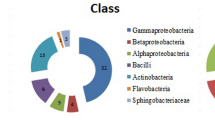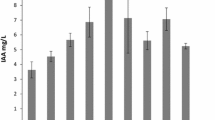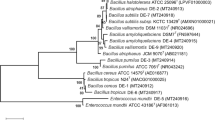Abstract
The efficacy of four potential phosphate solubilizing Enterobacter isolated from non-rhizospheric soil in Western ghat forest in India. Plant growth promoting ability of these isolates was evaluated in cowpea. All are gram negative, rod shaped, 0.8–1.6 mm in size, and psychrotrophic in nature, grow from 5 to 40°C (optimum temp. 28 ± 2°C). All isolates exhibits growth at a wide range of pH 6–12, optimum at pH 7.0 and tolerates up to 7% (w/v) salt concentration. 16S rRNA gene sequencing reveals the confirmation of isolates to Enterobacter aerogenes sp. (NII-0907 and NII-0929), Enterobacter cloacae subsp. cloacae sp. (NII-0931) and Enterobacter asburiae sp. (NII-0934) with which they share >99% sequence similarity. Under in vitro conditions, all the four isolates were found to produce indole acetic acid, P-solubilization and hydrogen cyanide. The P-solubilizing activity coincided with a concomitant decrease in pH of the medium (pH 7.0–<3.0). The plant growth promotion properties were demonstrated through a cow pea (Vigna unguiculata (L.) walp) based bioassay under greenhouse conditions. Although the bacterial inoculation was found to result in significant increment in root, shoot and biomass and it stimulated bacterial counts in the rhizosphere. Hence, these isolates can further formulated and used for field application.


Similar content being viewed by others
References
Ahmed S (1995) Agriculture–fertilization interface in Asia issue of growth and sustainability. Oxford and IBH publishing Co, New Delhi
Antoun HA, Beauchamp CJ, Goussard N, Chabot R, Lalande R (1998) Potential of rhizobium and bradyrhizobium species as plant growth promoting rhizobacteria on nonlegumes: effect on radishes (Raphanus sativus L.). Plant Soil 204:57–67
Arcand M, Schneider KD (2006) Plant- and microbial-based mechanisms to improve the agronomic effectiveness of phosphate rock: a review. An Acad Bras Cienc 78:791–807
Bakker AW, Schipper B (1987) Microbial cyanide production in the rhizosphere in relation to potato yield reduction and Pseudomonas spp. mediated plant growth stimulation. Soil Biol Biochem 19:451–457
Barea JM, Azco′ n R, Azco′ n-Aguilar C (2002) Mycorhizosphere interactions to improve plant fitness and soil quality. Antonie van Leeuwenhoek 81:343–351
Berleth T, Sachs T (2001) Plant morphogenesis: long distance coordination and local patterning. Curr Opin Plant Biol 4:57–62
Buch A, Archana G, Naresh KG (2008) Metabolic channelling of glucose towards gluconate in phosphate solubilizing Pseudomonas aeruginosa P4 under phosphorus deficiency. Res Microbiol 159:635–642
Cole R, Chai B, Farris RJ, Wang Q, Kulam SA, McGarrell DM, Garrity GM, Tiedje JM (2005) The ribosomal database project (RDP-II): sequences and tools for high-throughput rRNA analysis. Nucleic Acids Res 33:294–296
Collins CH, Lyne PM (1980) Microbiological methods. Butterworth and Co, London
Costacurta A, Vanderleyden J (1995) Synthesis of phytohormones by plant-associated bacteria. Crit Rev Microbiol 21:1–18
Gilbert GS, Parke JL, Clayton MK, Handelsman J (1993) Effects of an introduced bacterium on bacterial communities on roots. Ecology 74:840–854
Gordon AS, Weber RP (1951) Colorimetric estimation of indole acetic acid. Plant Physiol 26:192–195
Greenland D, Losleben M (2001) Structure and function of an alpine ecosystem. In: Bowman WD, Seastedt TR (eds) Climate. Oxford University Press, Niwot Ridge, Colorado, New York, pp 15–31
Gulati A, Rahi P, Vyas P (2008) Characterization of phosphate-solubilizing Fluorescent pseudomonads from the rhizosphere of seabuckthorn growing in the cold deserts of Himalayas. Curr Microbiol 56:73–79
Jones DL, Darrah PR (1994) Role of root derived organic acids in the mobilization of nutrients from the rhizosphere. Plant Soil 166:247–257
Kang SC, Ha CG, Lee TG, Maheshwari DK (2002) Solubilization of insoluble inorganic phosphate by a soil inhabiting fungus Fomitopsis sp. PS102. Curr Sci 82:439–442
Khalid A, Arshad M, Zahir ZA (2004) Screening plant growth promoting rhizobacteria for improving growth and yield of wheat. J Appl Microbiol 46:473–480
Kimura M (1980) A simple method for estimating evolutionary rate of base substitutions through comparative studies of nucleotide sequences. J Mol Evol 16:111–120
Kloepper JW, Beauchamp CJ (1992) A review of issues related to measuring of plant roots by bacteria. Can J Microbiol 38:1219–1232
Kravchenko LV, Borovkov AV, Pshikvil Z (1991) The possibility of auxin biosynthesis in wheat rhizosphere by associated nitrogen-fixing bacteria. Microbiol 60:927–931
Kumar S, Tamura K, Nei M (2004) MEGA3: integrated software for molecular evolutionary genetics analysis and sequence alignment. Brief Bioinform 5:150–163
Lifshitz R, Kloepper JW, Kozlowski M et al (1987) Growth promotion of canola (rape-seed) seedlings by a strain of Pseudomonas putida under gnotobiotic conditions. Can J Microbiol 8:102–106
Lucy M, Reed E, Glick BR (2004) Applications of free living plant growth-promoting rhizobacteria. Antonie van Leeuwenhoek 86:1–25
Martens DA, Frankenberger WT Jr (1994) Assimilation of exogenous 2–14C-indole acetic acid and 3–14C-tryptophan exposed to the roots of three wheat varieties. Plant Soil 166:281–290
Mehta S, Nautiyal CS (2001) An efficient method for qualitative screening of phosphate solubilizing bacteria. Curr Microbiol 43:51–56
Murphy JP, Riley JP (1962) A modified single solution method for the determination of the phosphate in natural waters. Anal Chem Acta 27:31–36
Park M, Kim C, Yang J, Lee H, Shin W, Kim S, Sa T (2005) Isolation and characterization of diazotrophic growth promoting bacteria from rhizosphere of agricultural crops of Korea. Microbiol Res 160:127–133
Peix A, Rivas-Boyero AA, Mateos PF, Rodriguez-Barrueco C, Martinez-Molina E, Velazquez E (2001) Growth promotion of chickpea and barley by a phosphate solubilizing strain of Mesorhizobium mediterraneum under growth chamber conditions. Soil Biol Biochem 33:103–110
Pieterse CMJ, van Pelt JA, van Wees SCM, Ton J, Leon-Kloosterziel KM, Keurentjes JJB, Verhagen BMW (2001) Rhizobacteria mediated induced systemic resistance: triggering, signaling and expression. Eur J Plant Pathol 107:51–61
Pikovskaya RI (1948) Mobilization of phosphorus in soil connection with the vital activity of some microbial species. Microbiologiya 17:350–362
Pradhan N, Sukla LB (2005) Solubilization of inorganic phosphate by fungi isolated from agriculture soil. Afr J Biotechnol 5:850–854
Richardson AE (2001) Prospects for using soil microorganism to improve the acquisition of phosphate by plant. Aust J Plant Physiol 28:897–906
Saitou N, Nei M (1987) The neighbor-joining method: a new method for reconstructing phylogenetic trees. Mol Biol Evol 4:406–425
Sarwar M, Arshad M, Martens DA, Frankenberger WT Jr (1992) Tryptophan-dependent biosynthesis of auxins in soil. Plant Soil 147:207–215
Schwyn B, Neilands JB (1987) Universal chemical assay for the detection and determination of siderophore. Anal Biochem 160:47–56
Son TTN, Diep CN, Giang TTM (2006) Effect of bradyrhizobia and phosphate solubilizing bacteria application on Soybean in rotational system in the Mekong delta. Omonrice 14:48–57
Sulbarán M, Pérez E, Ball MM, Bahsas A, Yarzábal LA (2009) Characterization of the mineral phosphate-solubilizing activity of Pantoea agglomerans MMB051 isolated from an iron-rich soil in southeastern Venezuela (Bolívar state). Curr Microbiol 58(4):378–383
Thompson JD, Gibson TJ, Plewniak F (1997) The Clustal X windows interface: flexible strategies for multiple sequence alignment aided by quality analysis tools. Nucleic Acids Res 24:4876–4882
Tsavkelova EA, Cherdyntseva TA, Botina SG, Netrusov AI (2007) Bacteria associated with orchid roots and microbial production of auxin. Microbiol Res 162:69–76
Whitelaw MA (2000) Growth promotion of plants inoculated with phosphate-solubilizing fungi. Adv Agron 69:99–151
Xu Y, Chen S, Kaufman MG, Maknojia S, Bagdasarian M, Walker ED (2008) Bacterial community structure in tree hole habitats of Ochlerotatus triseriatus: influences of larval feeding. J Am Mosq Control Assoc 24(2):219–227
Acknowledgments
The authors would like to thank CSIR Task force network programme on Exploration of India’s Rich Microbial Diversity (NWP 0006) for providing the financial support.
Author information
Authors and Affiliations
Corresponding authors
Additional information
C. K. Deepa and Syed G. Dastager contributed equally to the work.
Rights and permissions
About this article
Cite this article
Deepa, C.K., Dastager, S.G. & Pandey, A. Isolation and characterization of plant growth promoting bacteria from non-rhizospheric soil and their effect on cowpea (Vigna unguiculata (L.) Walp.) seedling growth. World J Microbiol Biotechnol 26, 1233–1240 (2010). https://doi.org/10.1007/s11274-009-0293-y
Received:
Accepted:
Published:
Issue Date:
DOI: https://doi.org/10.1007/s11274-009-0293-y




